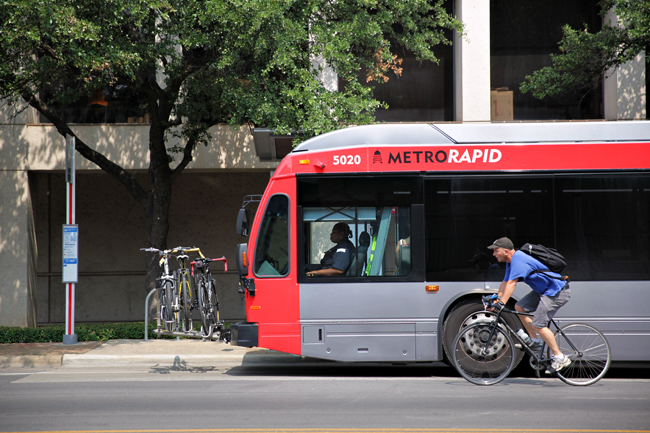The day before the end of spring break, my bus lurches through the streets of downtown Los Angeles. It’s a Sunday afternoon and I’m riding the LA Metro’s Silver Line, a Bus Rapid Transit system with deluxe buses in special lanes, on my way to LAX. Austin’s on my mind as I ride — not just because it’s where I’ll land in a few hours, but because a system like the Silver Line is being proposed for our city.
Project Connect, a study examining what can be done about Austin’s traffic, is analyzing a potential BRT system in the middle of Interstate 35. Last Monday, Capital Metro advanced the I-35 corridor — among other possible routes — to Project Connect’s second phase, which will recommend where Austin's next big transit investments should go. We should look to LA to understand how freeway BRT might work in Austin. After studying and experiencing the Silver Line myself, I believe that building BRT on I-35 would be a costly mistake.
Metro’s Silver Line resembles Capital Metro’s own MetroRapid, which hit Austin streets back in 2014. Both BRT systems use sleek, modern buses that make fewer stops and get prioritized by traffic signals. In theory, that means faster travel times — but thanks to construction and the usual downtown congestion, the Silver Line bus feels agonizingly slow.
The Silver Line bus leaves downtown and enters the toll lanes on the perpetually jammed Harbor Freeway. These lanes are the Silver Line’s selling point — like the ones now under construction on MoPac, they are dynamically priced so that traffic keeps moving. The idea is that the bus offers a reliable, affordable alternative to stewing in gridlock or paying up to $15 to get in the fast lane.
Planners projected that by bypassing traffic, the new Harbor Freeway “transitway” would lure massive numbers of drivers out of their cars. When it opened back in 1996, its buses were anticipated to get over 65,000 boardings per day. But just a decade later, they stood at a paltry 3,000. By 2014, Silver Line boardings had increased to 13,600 – a respectable climb, but still far short of what planners envisioned.
So why did the Silver Line flop?
Geography may provide an answer. To board its buses in the median of a freeway — exactly as in Project Connect’s I-35 proposal — riders must use pedestrian bridges that are dirty, ugly, and inhospitable — in a word, “ghetto.” What’s more, a 2005 report by the University of Southern California found that the strip malls and single-family homes surrounding the Harbor Freeway — not unlike like those along Interstate 35 — were not dense enough to justify a high-capacity transit service. “The current land use and physical infrastructure makes these station areas unattractive, unsafe, and disconnected from the larger urban fabric,” it summarized.
The Silver Line works well enough — it’s well-used by Angelenos during rush hour and it indeed got me to my destination. But I couldn’t help but feel that the millions spent on its elaborate stations, flyovers, and bus lanes were an enormous waste of public resources. Over the next year, as Project Connect planners contemplate an imitation on Interstate 35, they should look to Los Angeles for some tough lessons.
Ryan Young is a computer science senior from Bakersfield, California. He is a senior columnist.





















